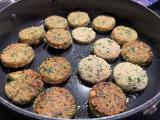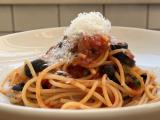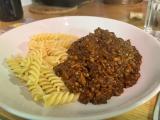Baked Eggplant with Ebly
Table of Contents
Jump to Recipe
Jump to Carbon Footprint
A few years ago I thought eggplant was a boring vegetable, but thanks to the Ottolenghi cookbooks I discovered how delicious it can be. In particular, baked eggplant is great: the flesh gets nice and tender and you can play around with toppings or garnishes.
This recipe is very simple, with a yoghurt dip and boiled ebly on the side. The cold yoghurt adds freshness and the ebly adds a little bite. Ebly are pre-cooked wheat berries, which has a slightly nutty taste and retains some bite after cooking - if you can’t find it, you can substitute pearl barley or bulgur.
The yoghurt dip is very simple, but of course you can vary it. In the Ottolenghi cookbook “Flavour”, there is a version with yoghurt butter milk sauce and pomegranate seeds, which is a bit more elaborate but very tasty. I also like Smitten Kitchen’s version with a tomato relish.
I would suggest za’atar as an optional but delicious topping. This is an oriental spice mix that you can either buy ready-made or make yourself: 1 part salt, 2 parts each dried oregano, marjoram and cumin, 4 parts each sesame seeds, sumac and thyme.

Recipe #
Baked Eggplant with Ebly
50 minutes
2 portions
Ingredients #
For the eggplants:
- 2 eggplants (about 800-1000 g)
- 1 clove of garlic
- 80 g olive oil
- 1 pinch of thyme
- 1 pinch of salt
- 1 pinch of pepper
- 1 pinch of chilli
- as a side dish: 100 g durum wheat berries (ebly)
For the sauce:
- 150 g natural yoghurt
- 25 g olive oil
- 5 g parsley
- 1 pinch of salt
- optional to serve: 1 teaspoon za’atar
Directions #
- Wash the eggplant, remove the ends and cut in half lengthways. Make a diamond-shaped cut in the flesh on the surface of each half to help it absorb the oil.
- Peel and chop the garlic. Mix with the olive oil, thyme, salt, pepper and chilli. Place the eggplants in an ovenproof dish and brush the sliced flesh with the spiced oil (if the eggplant does not absorb all of the oil, reserve some and brush the flesh again halfway through the baking).
- Bake in the oven at 200°C (fan oven) for about 45 minutes.
- While the eggplant is in the oven, prepare the sauce: Mix the natural yoghurt with olive oil, finely chopped parsley and salt.
- Meanwhile, cook the ebly (wheat berries) according to the instructions on the packet and keep warm until the eggplants are ready.
- The eggplant is ready when the flesh is clearly browned and soft. You can check this by piercing it with a fork.
- To serve, place one half of the eggplant on a plate and pour the yoghurt sauce over it. If you are using za’atar, sprinkle it over the yoghurt. Serve with the cooked wheat berries (ebly).
Carbon Footprint #
In total, two portions of baked eggplant with ebly have an estimated carbon footprint of 1070 g.
This ranks it number 15 out of 57 recipes published on the blog so far in terms of estimated carbon footprint.
It is therefore part of the best tertile (top 33%) of the recipes with the lowest emission impact. 🤗In particular, compared to the reference recipes with meat, the carbon footprint is significantly better: Compared to Spaghetti Bolognese, the estimated carbon footprint of the baked eggplant is about 72% lower. Overall, the carbon footprint of this recipe is very similar to the Grisons barley soup with vegetables with vegetables or the Lime Dal.
Looking at the individual ingredients, the eggplant in particular has a very good carbon footprint: Almost 70% of the weight of the ingredients, but only 15% of the estimated carbon footprint, comes from eggplants. Olive oil in particular contributes disproportionately to emissions - apart from the processing of the olives, this is mainly due to its frequent packaging in disposable glass bottles, which are relatively energy-intensive and heavy. Yoghurt (made from cow’s milk) also contributes more to the carbon footprint than its share of the weight of the ingredients would suggest.
| ingredient | carbon footprint per kg | carbon footprint (in g) for 2 servings | % of ingredients | % of CO2 emissions |
|---|---|---|---|---|
| Eggplant | 0.2 | 160 | 68% | 15% |
| Garlic | 0.4 | 1 | 0% | 0% |
| Olive oil | 3.2 | 256 | 7% | 24% |
| Thyme | 1.1 | 2 | 0% | 0% |
| Salt | 0.7 | 1 | 0% | 0% |
| Pepper | 1.1 | 1 | 0% | 0% |
| Chili powder | 1.1 | 1 | 0% | 0% |
| Ebly | 1.3 | 132 | 9% | 12% |
| Yogurt | 1.7 | 255 | 13% | 24% |
| Olive oil | 3.2 | 80 | 2% | 7% |
| Parsley | 1.0 | 5 | 0% | 0% |
| Salt | 0.7 | 1 | 0% | 0% |
| Za’atar | 1.1 | 3 | 0% | 0% |
| Bake eggplant | 150 | 14% | ||
| Cook ebly | 21 | 2% |


